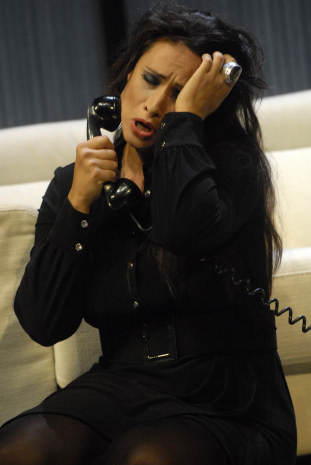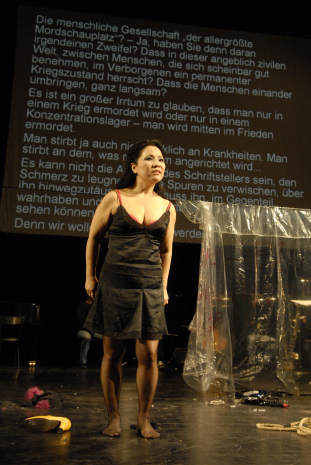Other Links
Editorial Board
- Editor - Bill Kenny
- London Editor-Melanie Eskenazi
- Founder - Len Mullenger
Google Site Search
SEEN
AND HEARD INTERNATIONAL OPERA REVIEW
Poulenc, La voix humaine, and Schoenberg, Pierrot lunaire: Angelas Blancas and Young-Hee Kim (sopranos), Leipzig Gewandhaus Orchestra, Josep Vicent and Johannes Harneit (conductors). Leipzig Opera House, 28.9.2008 (MB)
La voix
humaine
Oper Leipzig is certainly giving Schoenberg his due. One ought to be
able to say that about every opera company, every orchestra, every
concert hall in the world, but sadly not. Last season we were
treated – yes, treated – to a triple-bill of Schoenberg’s three
one-act operas. Now we have a staged version of Pierrot Lunaire
in a double-bill with Poulenc’s one-act opera, La voix humaine.
I should readily wager that these two works have rarely if ever been
performed together, Poulenc’s admiration for the Second Viennese
School and even for the young Boulez notwithstanding. There is, if
the truth be told, little to unite the two works, although as staged
here, Pierrot might be said, like La voix humaine, to
have a female protagonist. Aside from the strange description of the
former work’s reciter as ‘a woman who spends too much time on the
telephone’ and a brief re-appearance of the telephone from La
voix humaine, in which re-appearance its wire acted as a noose,
there was little to unite the productions either. This did not
matter; we simply experienced the two works – or perhaps better
Poulenc’s work and Peter Konwitschny’s take on Schoenberg’s work –
on more or less their own terms.
So was that of Pierrot lunaire. Peter Konwitschny contributed
an interesting if enigmatic note, although I was not at all sure how
it related to what we saw on stage. He claimed rightly: ‘this
production is not about the work itself.’ However, I did not readily
comprehend how it lent the work ‘expression by giving it back its
context’. Rather it seemed to me to impart a narrative or at least
scenes, which ‘worked’, even if it was difficult to explain why, or
how they connected with the music. As if Young-Hee Kim did not have
enough to worry about, she was called upon to arrive drunkenly on
stage, interact with the conductor and players, show us that she was
– as Alan Bennett might say – ‘in a bit of a state’, shoot herself,
and eventually perhaps – as Bennett might also say – ‘pull herself
together’. For instance, at the end of the ‘Valse de Chopin’, she
snatched the baton from Johannes Harneit’s hands, ran around
conducting (and continuing to recite), then stabbed pianist,
Christian Hornef with the baton and shouted of his death. Hornef had
to lie dead on the floor for a little time until rising to continue
with the re-entry of the piano at the end of the following number,
‘Madonna’. In principle, I have reservations about such a staged
approach, since it most likely restricts the workings of one’s
imagination, but it turned out rather well and is after all but one
attempt to present this irreducible, irrepressible, irresistible
work.
A
woman – Angeles Blancas
Christoph Meyer (director)
Ramon Ivars (designs, costumes)
Albert Faura (lighting)
Leipzig Gewandhaus Orchestra
Josep Vicent (conductor)
Pierrot lunaire
A
woman who spends too much time on the telephone – Young-Hee Kim
Peter Konwitschny (director)
Michaela Mayer-Michnay (costume collaboration)
Members of the Leipzig Gewandhaus Orchestra (Julius Bekesch –
violin, Dorothea Hemken – viola, Daniel Pfister – ’cello, Manfred
Ludwig – flute/piccolo, Voler Hemken (clarinet/bass clarinet)
Johannes Harneit (conductor)

La Voix Humaine
In Christoph Meyer’s production, first seen at Barcelona’s Gran
Teatre del Liceu, the setting for La voix humaine was simple
and much as originally envisaged. We saw a woman at home in the
aftermath of what we learned had been a suicide attempt; home gave
an impression of something credibly Parisian; the telephone was
there too. And so, rightly, the emphasis was upon Angelas Blancas,
whom Meyer directed with impeccable realism. Unless one were utterly
to overturn the premise of the work, I cannot imagine a symbolic
production working. Blancas’s movements, expressions, actions: all
seemed utterly believable. This, though, would have been as nothing
without her singing. When I say that Blancas proved herself a fine
singing actress, I do not mean to imply, as can sometimes be the
case, that her acting compensated for her singing, simply to say
that the two aspects were as one. Her portrayal of a woman’s last,
increasingly desperate telephone call to the lover who has jilted
her was not only moving but credible as half – or rather more than
that – of a several-times interrupted dialogue. Her looks and vocal
timbre also made one quite ready to believe that this was a
Parisienne: more full-blooded than the work’s creator, Denise Duval,
but none the worse for that. After all, La voix humaine has
attracted artists as different as Felicity Lott, Elisabeth
Soderström, and Jessye Norman. Blancas was quite at home in such
august company. She was helped by Josep Vicent’s conducting of the
Leipzig Gewandhaus Orchestra. That the length of the significant
pauses did not bring attention to itself is a considerable tribute,
since these are difficult to judge. Occasionally I wondered whether
the contrast between Stravinskian rhythm and sensual sweetness might
have been greater but to have underlined this might well have been
too great a disruption. The orchestra sounded warm and well-blended,
at home in Poulenc’s music without sacrificing its unmistakeably
German timbre. This was undoubtedly a fine performance.

Pierrot Lunaire
Kim’s performance was undoubtedly that of a singing – and speaking
and various things-in-between... – actress. She varied the
ever-shifting balance according to the needs of the performance,
which is as it should be, and showed herself attentive to the
bizarre words, producing so many different sounds in a single line –
‘So modern sentimental geworden! – of ‘Heimweh’. Harneit, sometimes
called upon to act too, directed members of the Leipzig Gewandhaus
Orchestra with great aplomb. He struck a fine balance – there can
surely be no one correct balance – between precision and expression,
Romanticism and modernism, decadence and construction. Nightmarish
dance rhythms really told.
Most important, Harneit allowed the players room to perform, both as
soloists and as members of the ensemble – and of course, with Young-Hee
Kim. They also had to speak – reciting the final ‘Rote, fürstliche
Rubine’ of the tenth number. Manfred Ludwig switched artfully
between flute and piccolo, always ensuring that the latter was an
instrument of musical expression, never merely shrill. Hornef
displayed a commendable grasp of Schoenberg’s piano style, virtuosic
and idiomatic throughout. I was greatly impressed by the combination
of shrieking hysteria from both Kim and Volker Hemken’s clarinet in
‘Rote Messe. They cleverly mirrored one another, producing chamber
music, not simply effect. As Stravinsky once remarked, Pierrot
is – amongst so many other things – an instrumental masterpiece.
This was equally apparent in the Romanticism we heard from Daniel
Pfister’s ’cello in ‘Serenade’, a performance whose equally audible
constructivism also pointed the way forward to the Op.24 Serenade.
We had a violinist and a violist, which makes sense, since few
players have equal command of both instruments. Julius Bekesch
showed himself adept at following – and leading – the ever-shifting
moods of this nightmare; a particular highlight was his sweetness of
tone in ‘Heimfahrt’, married as always to perfect rhythmical
precision. Dorothea Hemken’s rich viola contributed with Hornef’s
neo-Brahmsian piano part to the impression in the final ‘O alter
Duft’ of a perverted, distorted Lied. It then remained for
our heroine (?) to bid us farewell, a modern wayfarer of sorts. I
doubt that I shall forget this performance.
Pictures ©
Andreas Birkigt
Back
to Top
Cumulative Index Page
